Impact of the Minimum Head on Low-Head Hydropower Plants Energy Production and Profitability
Abstract
1. Introduction
2. Problem Description
- average low flow—26 m3/s (SNQ);
- average flow from the average annual flows—54 m3/s (SSQ);
- average high flow—97 m3/s (SWQ).
3. Model and Method Description
3.1. Estimating Energy Production—Small Hydropower Plant Model
3.2. Economic Model
4. Results
4.1. Estimating Energy Production
4.2. Estimating Cost–Efficiency
5. Discussion
6. Conclusions
Author Contributions
Funding
Acknowledgments
Conflicts of Interest
Abbreviations
| CAPEX | capital expenditures |
| FOM | fixed operational cost |
| LCOE | levelized cost of electricity |
| MC | Monte Carlo simulation |
| NPV | net present value |
| SHP | small-scale hydropower |
| SNQ | average low flow |
| SSQ | average flow from the average flows |
| SWR | average high flow |
| TSO | transmission system operator |
| VOM | variable operational cost |
Appendix A
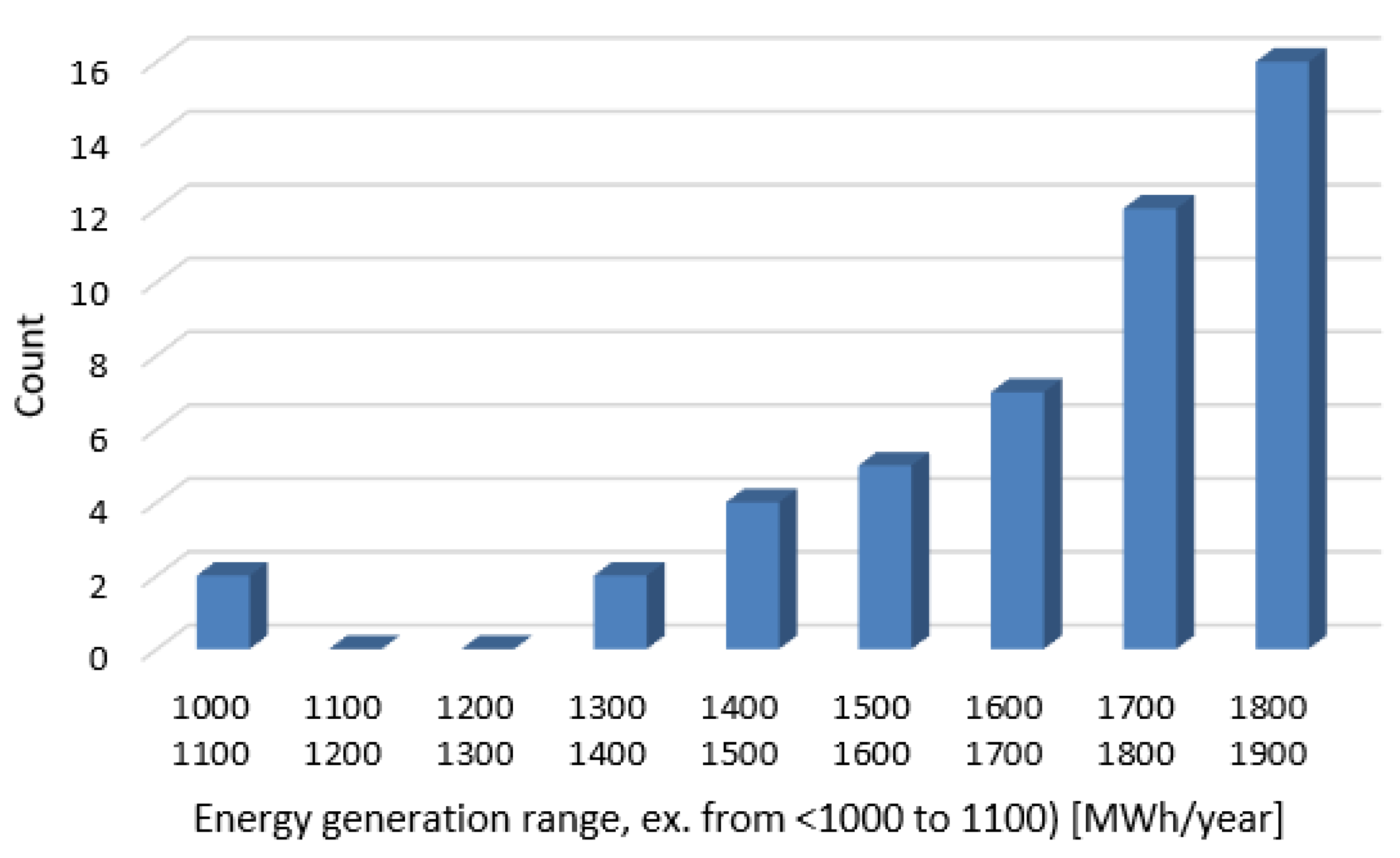
| Range [MWh] | % Probability |
|---|---|
| (1000–1100> | 4.17% |
| (1100–1200> | 0.00% |
| (1200–1300> | 0.00% |
| (1300–1400> | 4.17% |
| (1400–1500> | 8.33% |
| (1500–1600> | 10.42% |
| (1600–1700> | 14.58% |
| (1700–1800> | 25.00% |
| (1800–1900> | 33.33% |
| Range [MWh] | Cumulative probability |
|---|---|
| (1000–1100> | 4.17% |
| (1100–1200> | 4.17% |
| (1200–1300> | 4.17% |
| (1300–1400> | 8.33% |
| (1400–1500> | 16.67% |
| (1500–1600> | 27.08% |
| (1600–1700> | 41.67% |
| (1700–1800> | 66.67% |
| (1800–1900> | 100.00% |
- Step 1. Generate random numbers p(1) from a uniform distribution ranging from 0 to 1;
- Step 2. For the generated number, check if it is less than the cumulative probability for the first range (1000–1100 MWh). For example, if that is the case, the random number p(1) was 0.02, proceed to Step 3; if not, proceed to Step 4;
- Step 3. For the range for which the p number was smaller than the cumulative probability, generate another number from a uniform distribution in which minimum and maximum values are, as in the range boundaries, for the case that would mean generating a number from a uniform distribution ranging from 1000 to 1100 MWh. The generated number is then the first simulated energy generation value. Proceed to Step 1 to generate the following energy generation values;
- Step 4. In this step, move to the next range and its cumulative probability values. If the cumulative probability values are similar for two or more ranges, remove the subsequent ones and keep only the first one. In Table A2, the range 1000–1100 would be kept only, while 1100–1200, 1200–1300 would have to be removed. Select the first range for which the p number is smaller than its cumulative probability value. For example, for p equal to 0.25, it would be range 1500–1600. For p equal to 0.6, it would be 1700–1800. Repeat this step until the p-value is assigned to the range. If found, proceed to step 1;
- Step 5. The simulation ends when the desired number of energy generation numbers has been reached.
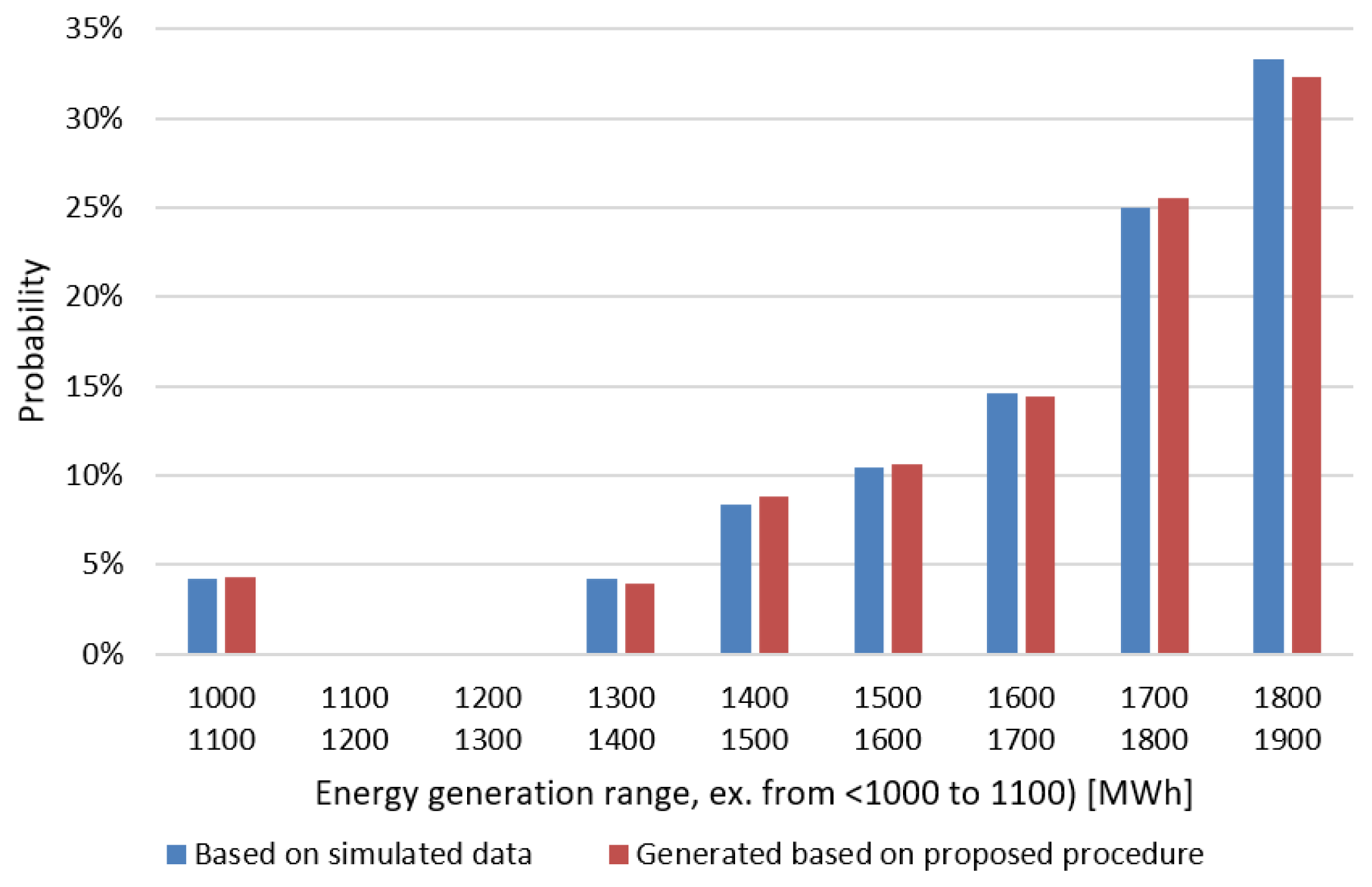
References
- Ceran, B. Influence of the CO2 emission factor value on the result of the load distribution analysis between the hybrid PV/WT/FC system and the electric power system. E3S Web Conf. 2019, 108, 01016. [Google Scholar] [CrossRef]
- Szczerbowski, R.; Ceran, B. Development perspectives of the Polish power generation sector according to the climate preservation conference COP21 policies. E3S Web Conf. 2017, 14, 01003. [Google Scholar] [CrossRef]
- Polish Power Networks (In Polish: Polskie Sieci Elektroenergetyczne). Available online: https://www.pse.pl/web/pse-eng (accessed on 20 May 2020).
- Hoes, O.; Meijer, L.; van der Ent, R.; van de Giesen, N. Systematic high-resolution assessment of global hydropower potential. PLoS ONE 2017, 12. [Google Scholar] [CrossRef] [PubMed]
- Balkhair, K.S.; Ur Rahman, K. Sustainable and economical small-scale and low-head hydropower generation: A promising alternative potential solution for energy generation at local and regional scale. Appl. Energy 2017, 188, 378–391. [Google Scholar] [CrossRef]
- Bódis, K.; Monforti, F.; Szabó, S. Could Europe have more mini hydro sites? A suitability analysis based on continentally harmonized geographical and hydrological data. Renew. Sustain. Energy Rev. 2014, 37, 794–808. [Google Scholar] [CrossRef]
- Wiemann, P.; Muller, G.; Senior, J. Review of current developments in low head, small hydropower. In Proceedings of the 32nd IAHR Conference 2007, Venice, Italy, 1–6 July 2007. [Google Scholar]
- Kowalczyk, K.; Cieśliński, R. Analysis of the hydroelectric potential and the possibilities of its use in the Pomeranian voivodeship. Woda-Środowisko-ObszaryWiejskie 2018, 18, 69–86. [Google Scholar]
- Punys, P.; Kvaraciejus, A.; Dumbrauskas, A.; Šilinis, L.; Popa, B. An assessment of micro-hydropower potential at historic watermill, weir, and non-powered dam sites in selected EU countries. Renew. Energy 2019, 133, 1108–1123. [Google Scholar] [CrossRef]
- Zhou, D.; Deng, Z.D. Ultra-low-head hydroelectric technology: A review. Renew. Sustain. Energy Rev. 2017, 78, 23–30. [Google Scholar] [CrossRef]
- Lavrič, H.; Rihar, A.; Fišer, R. Assessment of electrical energy production in small hydropower plant with ultra-low head. In Proceedings of the 2013 International Conference-Workshop Compatibility and Power Electronics, Ljubljana, Slovenia, 5–7 June 2013. [Google Scholar] [CrossRef]
- Quaranta, E. Stream water wheels as renewable energy supply in flowing water: Theoretical considerations, performance assessment and design recommendations. Energy Sustain. Dev. 2018, 45, 96–109. [Google Scholar] [CrossRef]
- Budiarso, B.; Helmizar, H.; Warjito; Nuramal, A.; Ramadhanu, W.; Adanta, D. Performance of breastshot waterwheel in run of river conditions. In AIP Conference Proceedings; AIP Publishing LLC: New York, NY, USA, 2020; Volume 2227, p. 020014. [Google Scholar] [CrossRef]
- Quarantaa, E.; Revelli, R. Gravity water wheels as a micro hydropower energy source: A review based on historic data, design methods, efficiencies and modern optimizations. Renew. Sustain. Energy Rev. 2018, 97, 414–427. [Google Scholar] [CrossRef]
- Zhao, M.; Zheng, Y.; Yang, C.; Zhang, Y.; Tang, Q. Performance Investigation of the Immersed Depth Effects on a Water Wheel Using Experimental and Numerical Analyses. Water 2020, 12, 982. [Google Scholar] [CrossRef]
- Quaranta, E.; Müller, G. Optimization of undershot water wheels in very low and variable flow rate applications. J. Hydraul. Res. 2019, 1–5. [Google Scholar] [CrossRef]
- Lavrič, H.; Rihar, A.; Fišer, R. Influence of equipment size and installation height on electricity production in an Archimedes screw-based ultra-low head small hydropower plant and its economic feasibility. Renew. Energy 2019, 142, 468–477. [Google Scholar] [CrossRef]
- Rohmer, J.; Knittel, D.; Sturtzer, G.; Flieller, D.; Renaud, J. Modeling and experimental results of an Archimedes screw turbine. Renew. Energy 2016, 94, 136–146. [Google Scholar] [CrossRef]
- Siswantara, A.I.; Siswantara, A.I.; Warjito; Budiarso, B.; Harmadi, R.; Syafei, M.H.; Adanta, D. Investigation of the α angle’s effect on the performance of an Archimedes turbine. Energy Procedia 2017, 156, 458–462. [Google Scholar] [CrossRef]
- Songin, K.; Lubitz, W. Measurement of fill level and effects of overflow in power-generating Archimedes screws. J. Hydraul. Res. 2019, 57, 635–646. [Google Scholar] [CrossRef]
- Dellinger, G.; Simmons, S.; Lubitz, W.D.; Garambois, P.; Dellinger, N. Effect of slope and number of blades on Archimedes screw generator power output. Renew. Energy 2019, 136, 896–908. [Google Scholar] [CrossRef]
- Lubitz, W.D.; Lyons, M. Archimedes Screws for Microhydro Power Generation. In Proceedings of the ASME 2013 7th International Conference on Energy Sustainability, Minneapolis, MN, USA, 14–19 July 2013. [Google Scholar] [CrossRef]
- Khan, A.; Khattak, A.; Ulasyar, A.; Imran, K.; Munir, M.A. Investigation of Archimedes Screw Turbine for Optimal Power Output by Varying Number of Blades. In Proceedings of the 2019 International Conference on Electrical, Communication, and Computer Engineering (ICECCE), Swat, Pakistan, 24–25 July 2019; pp. 1–6. [Google Scholar] [CrossRef]
- Lavrič, H.; Rihar, A.; Fišer, R. Simulation of electrical energy production in Archimedes screw-based ultra-low head small hydropower plant considering environment protection conditions and technical limitations. Energy 2018, 164, 87–98. [Google Scholar] [CrossRef]
- Zhu, L.; Zhang, H.P.; Zhang, J.G.; Meng, X.C.; Lu, L. Performance of a bulb turbine suitable for low prototype head: Model test and transient numerical simulation. Conf. Ser. Earth Environ. Sci. 2012, 15, 042032. [Google Scholar] [CrossRef]
- Mulu, B.G.; Jonsson, P.P.; Cervantes, M.J. Experimental investigation of a Kaplan draft tube—Part I: Best efficiency point. Appl. Energy 2012, 93, 695–706. [Google Scholar] [CrossRef]
- Abeykoon, C.; Hantsch, T. Design and Analysis of a Kaplan Turbine Runner Wheel. In Proceedings of the 3rd World Congress on Mechanical, Chemical, and Material Engineering (MCM’17), Rome, Italy, 8–10 June 2017. HTFF 151/1-16. [Google Scholar] [CrossRef]
- Abbas, A.; Qandil, M.; Al-Haddad, M.; Amano, R.S. Performance Investigation of Very-Low-Head Kaplan Hydro-Turbines. In Proceedings of the AIAA SciTech 2019 Forum, San Diego, CA, USA, 7–11 January 2019. [Google Scholar] [CrossRef]
- Water Turbines Works—Poland. Available online: https://www.wtw-poland.com/en/offer (accessed on 7 April 2020).
- Elbatran, A.H.; Yaakob, O.B.; Ahmed, Y.M.; Shabara, H.M. Operation, performance and economic analysis of low head micro-hydropower turbines for rural and remote areas: A review. Renew. Sustain. Energy Rev. 2015, 43, 40–50. [Google Scholar] [CrossRef]
- Nuernbergk, D.M.; Rorres, C. Analytical Model for Water Inflow of an Archimedes Screw Used in Hydropower Generation. J. Hydraul. Eng. 2013, 139, 213–220. [Google Scholar] [CrossRef]
- Saroinsong, T.; Soenoko, R.; Wahyudi, S.; Wahyudi, S. Fluid Flow Phenomenon in a Three-Bladed Power-Generating Archimedes Screw Turbine. J. Eng. Sci. Technol. Rev. 2016, 9, 72–79. [Google Scholar] [CrossRef]
- Raza, A.; Xu, D.; Mian, M.S.; Ahmed, J. A micro hydro power plant for distributed generation using municipal water waste with Archimedes screw. In Proceedings of the 2013 16th International Multi Topic Conference, Lahore, Pakistan, 19–20 December 2013; pp. 66–71. [Google Scholar] [CrossRef]
- Rohmer, J.; Sturtzer, G.; Knittel, D.; Flieller, D.; Renaud, J. Dynamic model of small hydro plant using Archimedes screw. In Proceedings of the 2015 IEEE International Conference on Industrial Technology (ICIT), Seville, Spain, 17–19 March 2015; pp. 987–992. [Google Scholar] [CrossRef]
- Breeze, P. Hydropower. In Power Generation Technologies, 3rd ed.; Breeze, P., Ed.; Newnes: Oxford, UK, 2019; pp. 173–201. [Google Scholar] [CrossRef]
- Quaranta, E. Optimal Rotational Speed of Kaplan and Francis Turbines with Focus on Low-Head Hydropower Applications and Dataset Collection. J. Hydraul. Eng. 2019, 145. [Google Scholar] [CrossRef]
- Kim, H.-H.; Rakibuzzaman, M.; Kim, K.; Suh, S.-H. Flow and Fast Fourier Transform Analyses for Tip Clearance Effect in an Operating Kaplan Turbine. Energies 2019, 12, 264. [Google Scholar] [CrossRef]
- Yang, W.; Wu, Y.; Liu, S. A modification method on runner blades in a Bulb turbine. Iop Conference Series: Earth and Environmental Science 2010, 12, 012003. [Google Scholar] [CrossRef]
- Report on Preparing Flood Danger Maps and Flood Risk Map (In Polish: Raport z Wykonania Map Zagrożenia Powodziowego i Map Ryzyka Powodziowego). Available online: https://www.kzgw.gov.pl/files/mzp-mrp/zal1.pdf (accessed on 10 July 2020).
- Electricity Generation from Renewable Energy Sources in Poland—The Presidents of the Energy Regulatory Office Report in 2019 (In Polish: Wytwarzanie energii elektrycznej w Polsce w małych instalacjach OZE—RaportPrezesa URE za 2019 rok). Available online: https://bip.ure.gov.pl/bip/o-urzedzie/zadania-prezesa-ure/raport-oze-art-17-ustaw/3556,Raport-zbiorcze-informacje-dotyczace-wytwarzania-energii-elektrycznej-z-odnawial.html (accessed on 10 July 2020).
- Płaczek, J.; Dysarz, T.; Wicher-Dysarz, J. Analysis of selected dams operation in the reach of the Noteć Bystra during the flood hazard conditions. Acta Scientiarum Polonorum. Formatio Circumiectus 2016, 15, 295–307. [Google Scholar] [CrossRef]
- The Inventory of the Constituent Parts of Inland Waterways of Special Transport Significance (In Polish: Inwentaryzacja części Składowych Śródlądowych dróg Wodnych o Szczególnym Znaczeniu transportowym). Available online: https://mgm.gov.pl/wp-content/uploads/2017/11/inwentaryzacja-czesci-skladowych-srodladowych-drog-wodnych-o-szczegolnym-znaczeniu-transportowym.pdf (accessed on 10 July 2020).
- Manning’s Equation—Manning’s n Values. Available online: http://www.fsl.orst.edu/geowater/FX3/help/8_Hydraulic_Reference/Mannings_n_Tables.htm (accessed on 10 July 2020).
- Institute of Meteorology and Water Management National Research Institute—Hydrological data (In Polish: Instytut Meteorologii i Gospodarki Wodnej Państwowy Instytut Badawczy—Dane hydrologiczne). Available online: https://dane.imgw.pl/data/dane_pomiarowo_obserwacyjne/dane_hydrologiczne/ (accessed on 10 July 2020).
- Carlsson, J.; Fortes, M.D.M.P.; de Marco, G.; Giuntoli, J.; Jakubcionis, M.; Jäger-Waldau, A.; Sigfusson, B. ETRI 2014-Energy Technology Reference Indicator Projections for 2010–2050; European Commission, Joint Research Centre, Institute for Energy and Transport; Publications Office of the European Union: Luxembourg, 2014. [Google Scholar]
- Paska, J. Assessment methodology for costs of electricity generation. Rynek Energii 2012, 2, 24–28. [Google Scholar]
- TAURON Polska Energia, S.A. Available online: https://media.tauron.pl/pr/360947/elektrownie-wodne-tauron-zwyciezcami-aukcji-oze (accessed on 10 July 2020).
- Archimedes screw distributor’s page. Available online: http://dobraenergia.info/ (accessed on 10 July 2020).
- Kuriqi, A.; Pinheiro, A.N.; Sordo-Ward, A.; Garrote, L. Water-energy-ecosystem nexus: Balancing competing interests at a run-of-river hydropower plant coupling a hydrologic–ecohydraulic approach. Energy Convers. Manag. 2020, 223, 113267. [Google Scholar] [CrossRef]
- Eurostat—Electricity Price Statistics. Available online: https://ec.europa.eu/eurostat/statistics-explained/index.php/Electricity_price_statistics (accessed on 10 July 2020).
Publisher’s Note: MDPI stays neu-tral with regard to jurisdictional claims in published maps and insti-tutional affiliations |
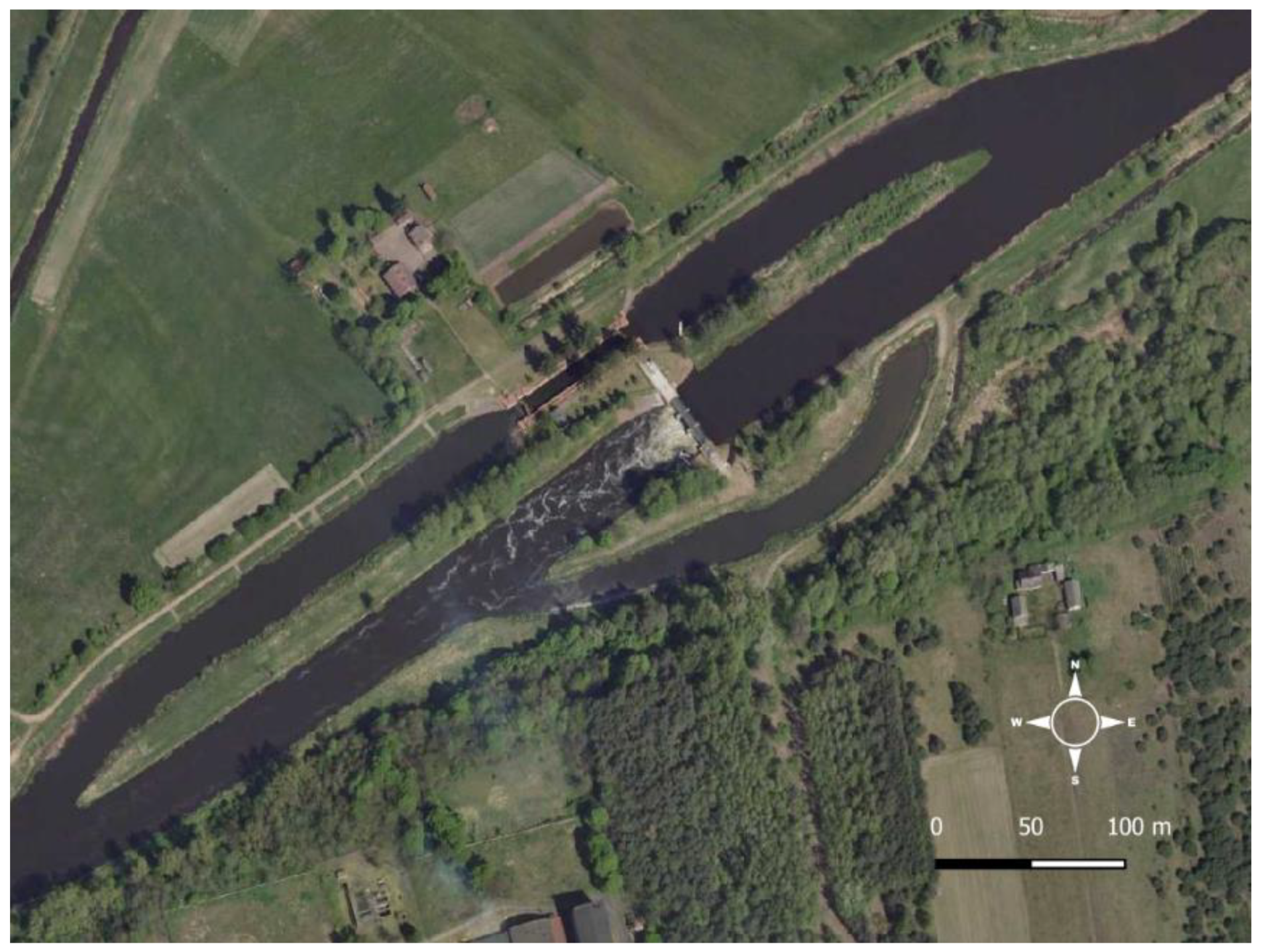

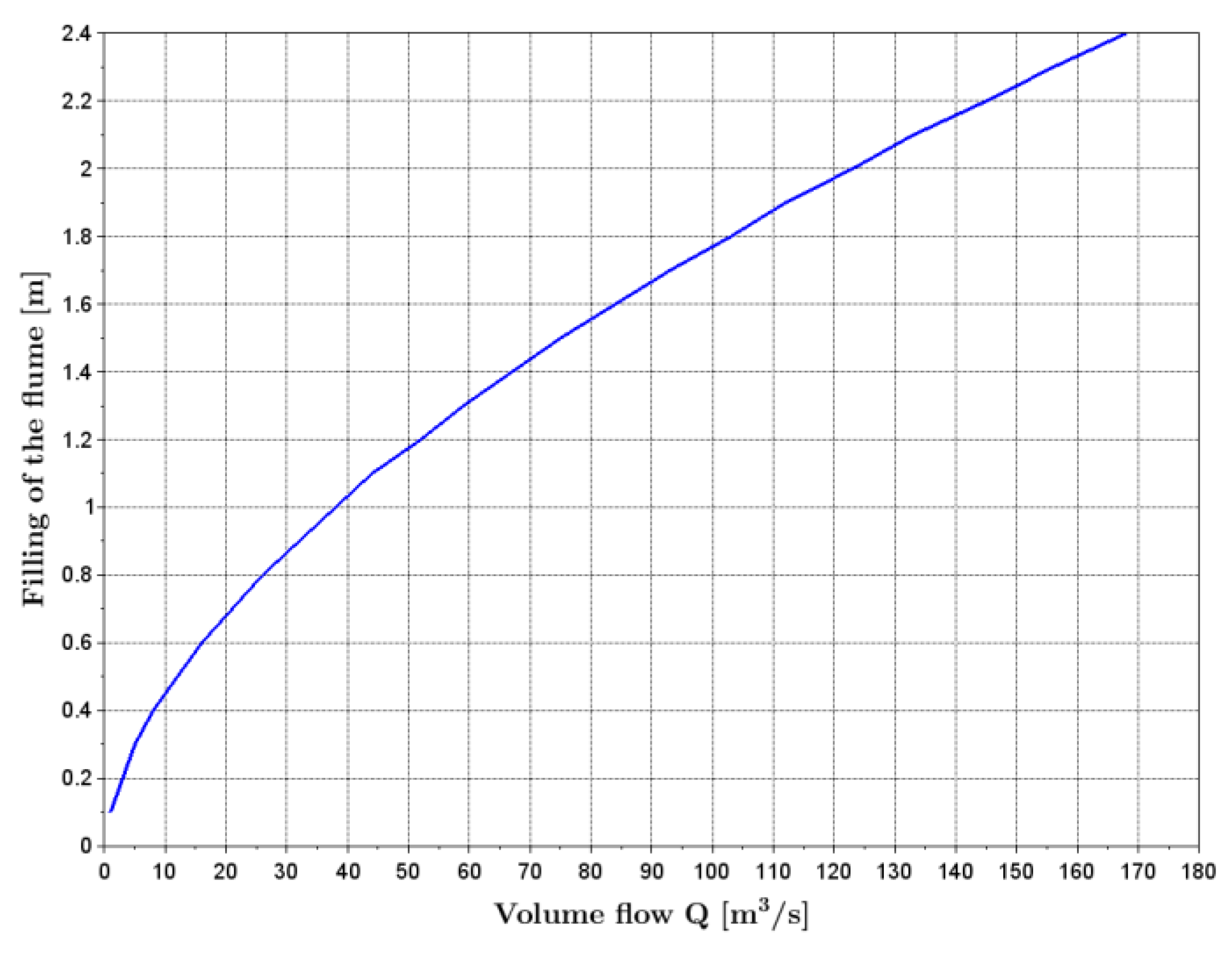
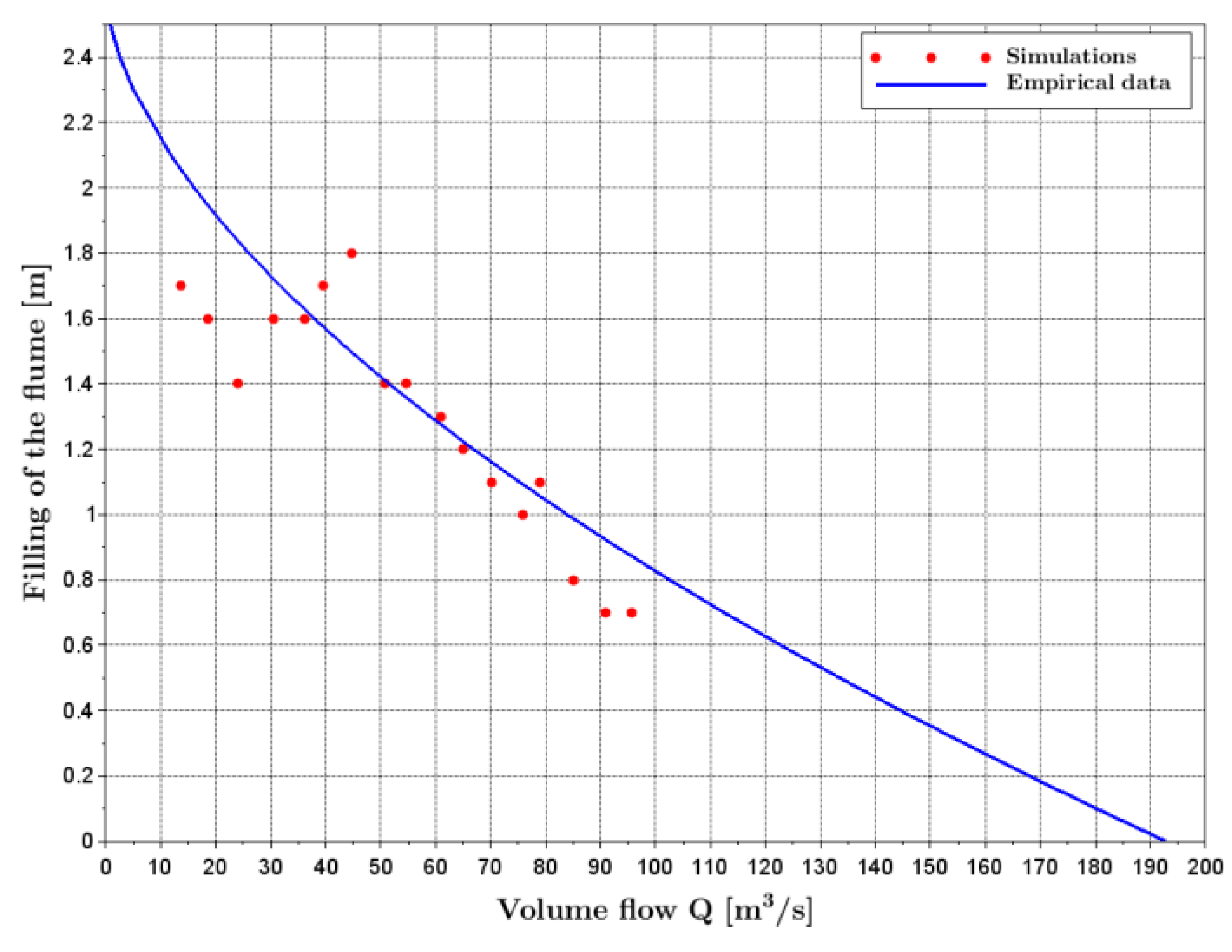
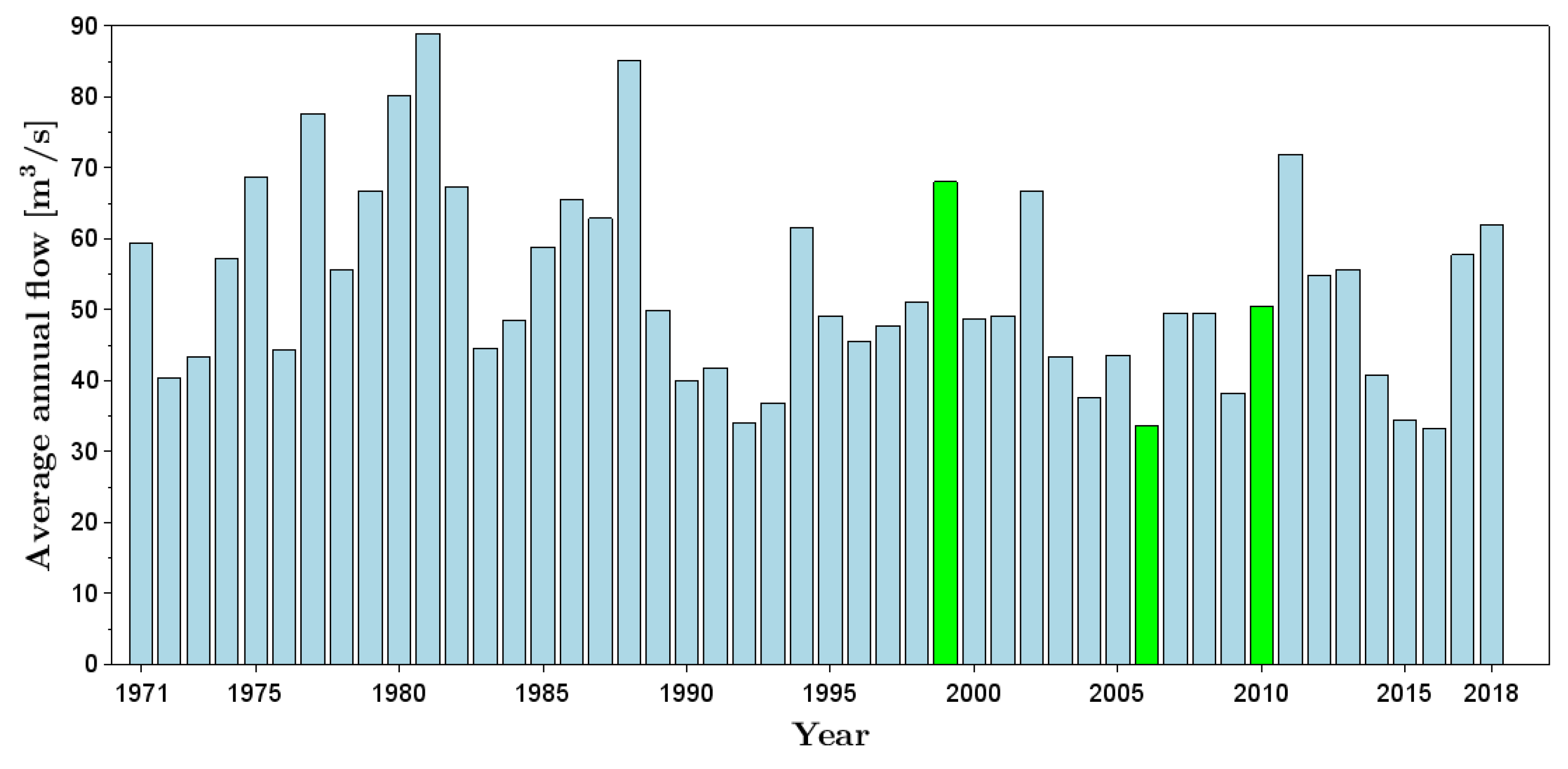
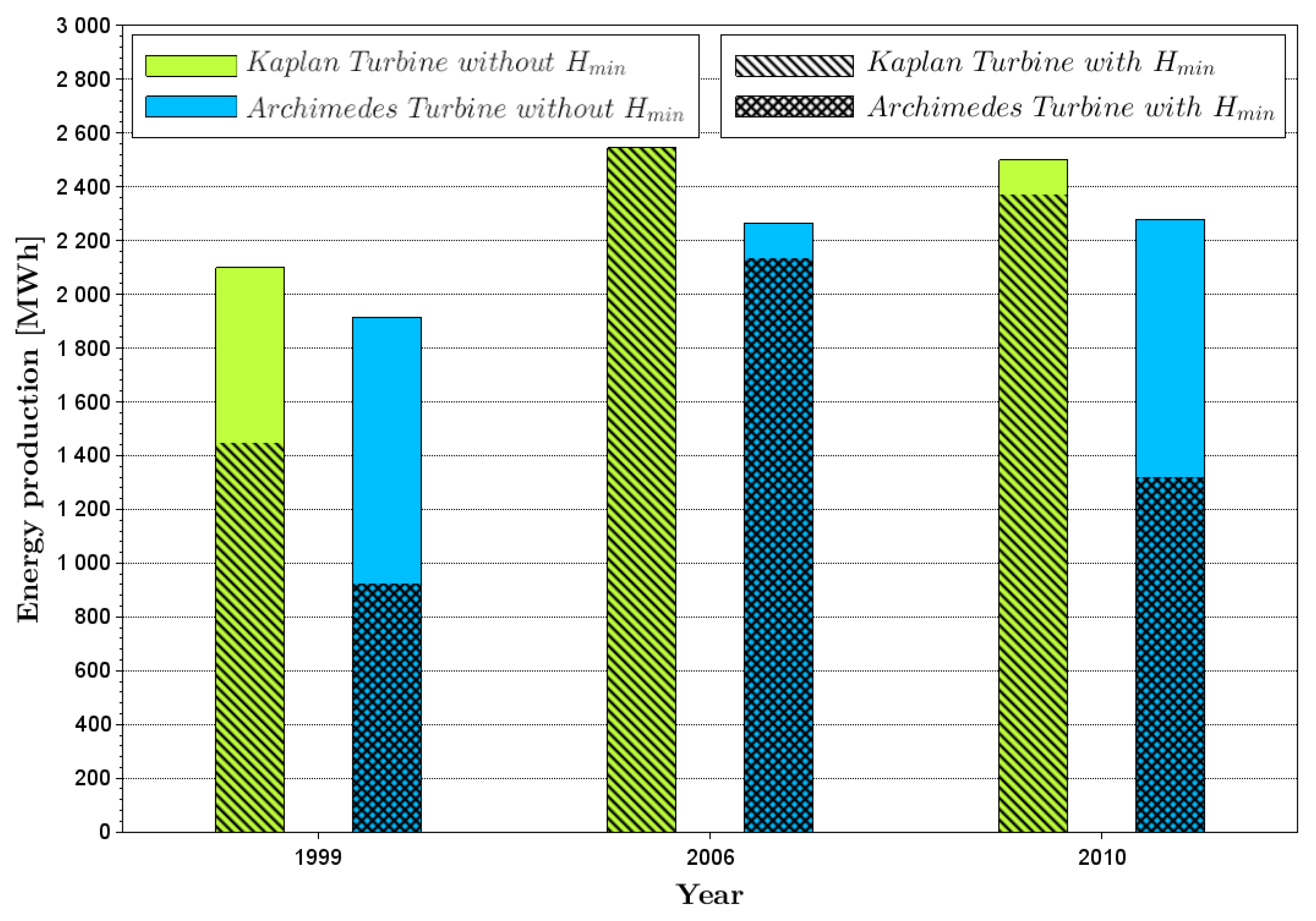
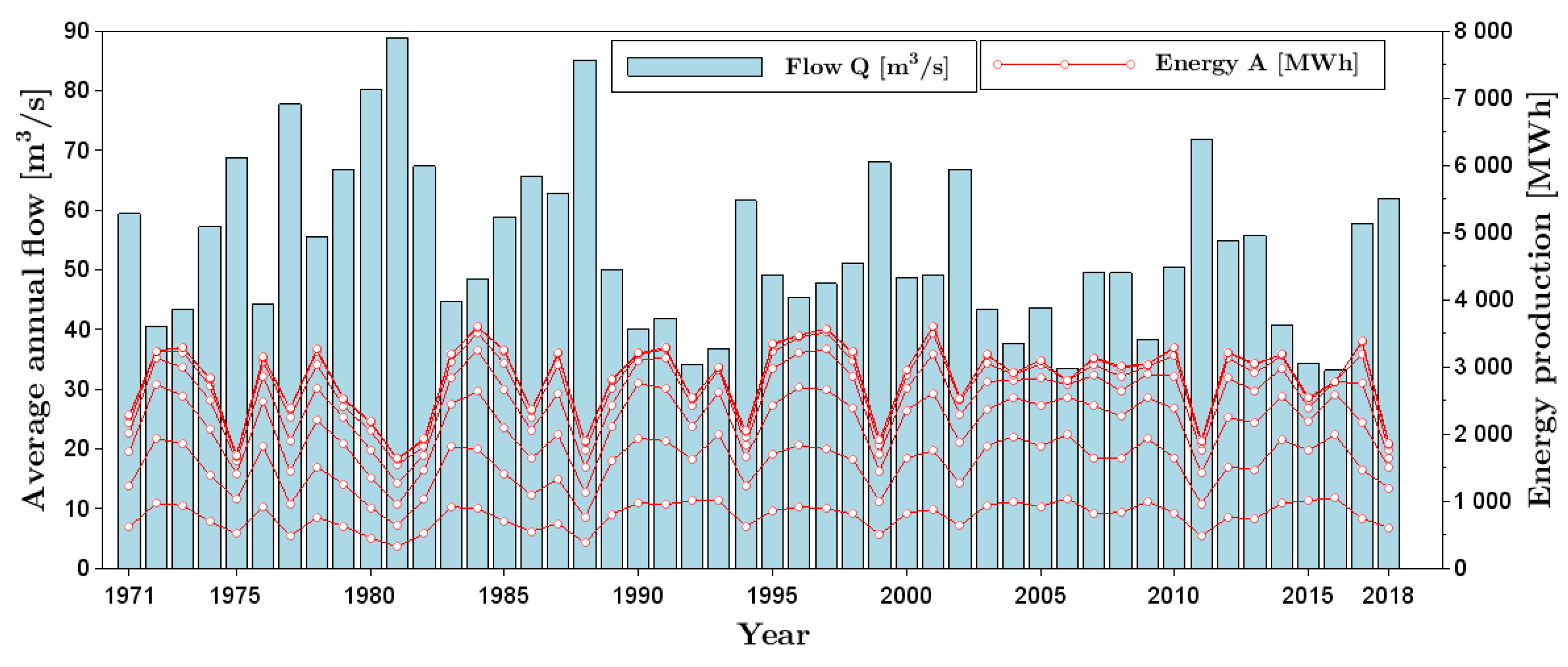
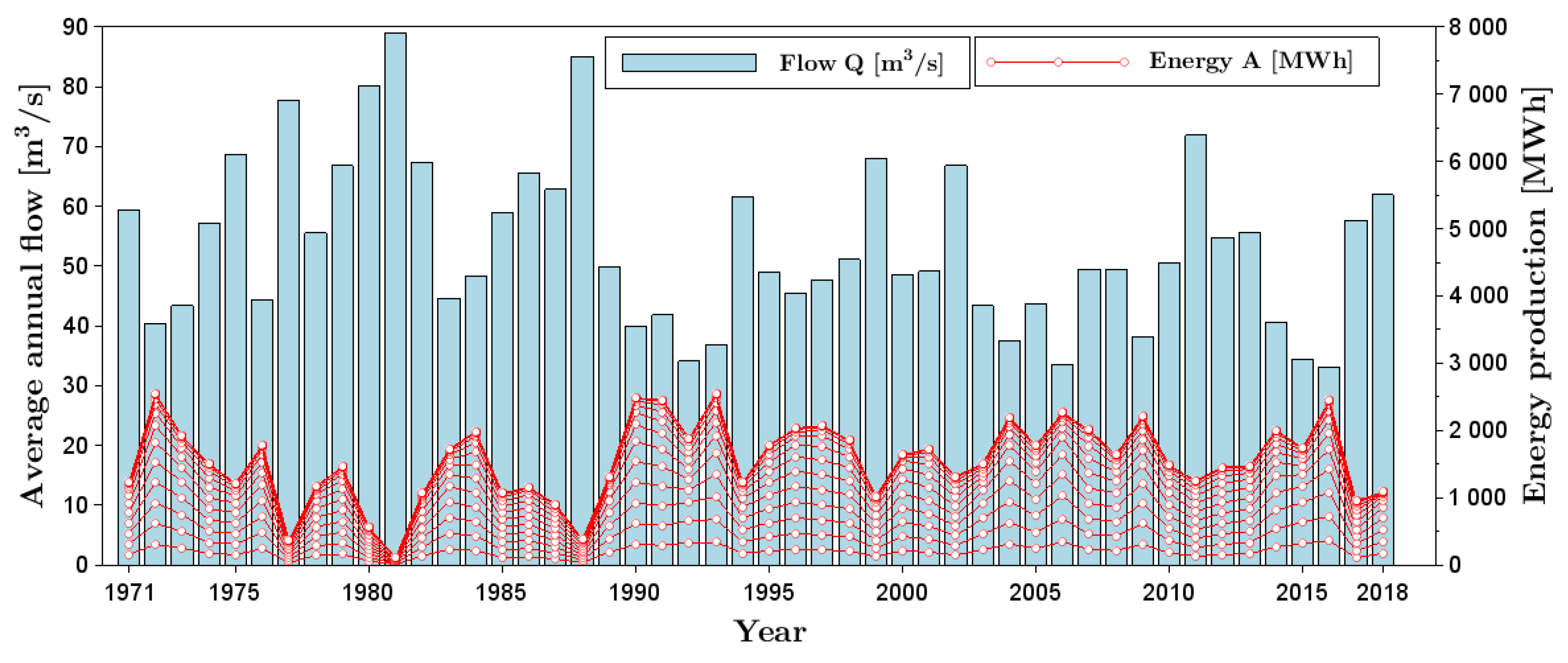
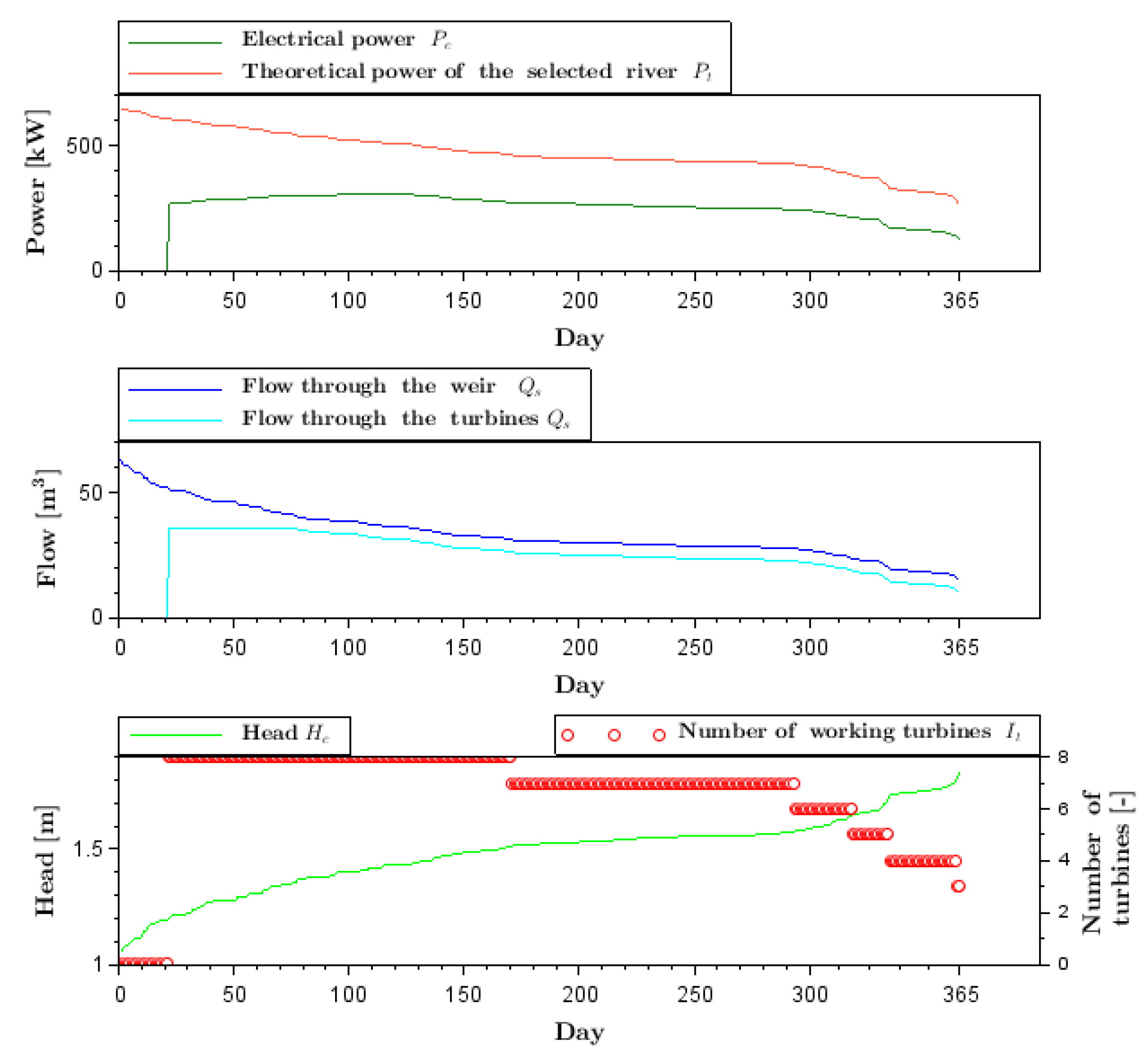

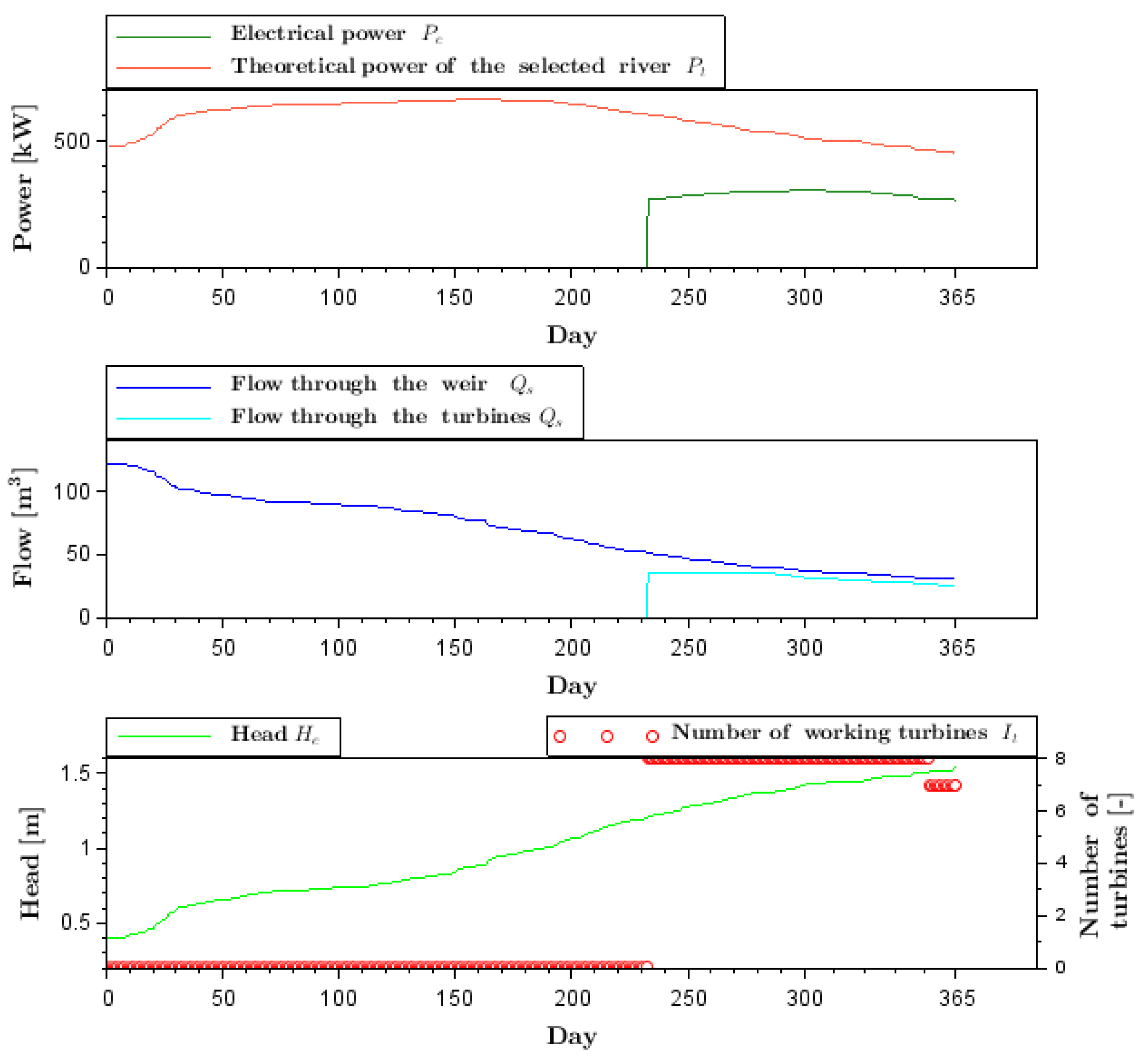

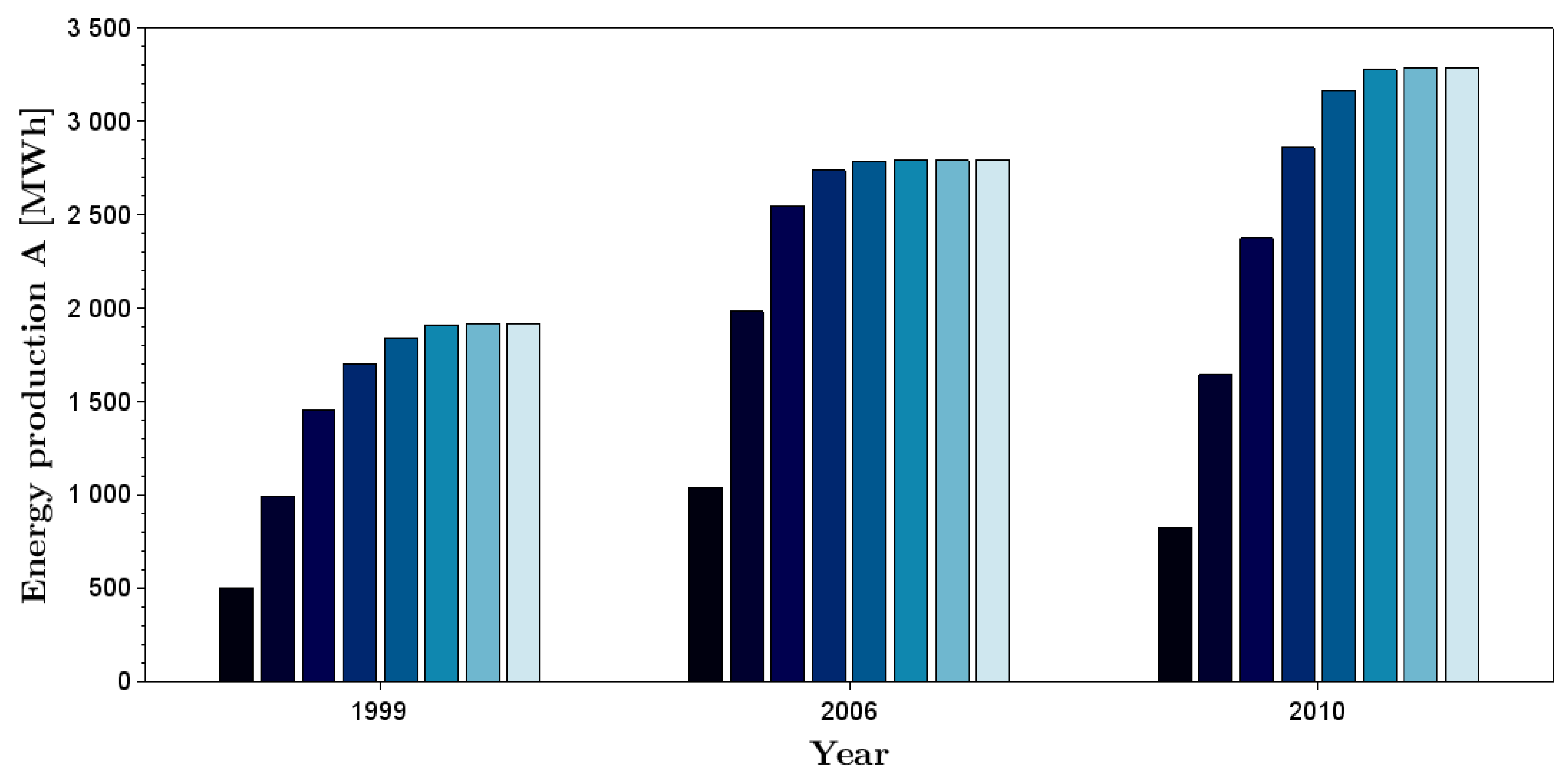


| Parameter | Data | Unit |
|---|---|---|
| n | 0.035 | s/m1/3 |
| I | 0.002 | - |
| b | 29.2 | m |
| Parameter | Value | Comment |
|---|---|---|
| Lifetime/investment period | 60 years (Carlsson, 2014) | Assuming continuous maintenance works |
| Return rate/Discount rate 1 | 5.0% (Paska, 2012) | Typical for RES investment in Poland |
| Fixed operational cost (FOM) | 1.5% (Carlsson, 2014) | Of CAPEX |
| Variable operational cost (VOM) | 3% (Carlsson, 2014) | Of CAPEX |
| Capital expenditures (CAPEX) | min: 2540, mean: 5600, max 8150. All euros/kW. (Carlsson, 2014) | Simulated in MC as a triangular distribution. |
| Certificate for hydro generation | 120 euros/kWh [47] | The latest auction won by the major hydro producer in Poland |
| Number of MC runs | 10,000 | Trial and error estimation |
| Kaplan capacity | 405 kW | Own assumptions |
| Archimedes capacity | 398.4 kW | Own assumptions |
Publisher’s Note: MDPI stays neutral with regard to jurisdictional claims in published maps and institutional affiliations. |
© 2020 by the authors. Licensee MDPI, Basel, Switzerland. This article is an open access article distributed under the terms and conditions of the Creative Commons Attribution (CC BY) license (http://creativecommons.org/licenses/by/4.0/).
Share and Cite
Ceran, B.; Jurasz, J.; Wróblewski, R.; Guderski, A.; Złotecka, D.; Kaźmierczak, Ł. Impact of the Minimum Head on Low-Head Hydropower Plants Energy Production and Profitability. Energies 2020, 13, 6728. https://doi.org/10.3390/en13246728
Ceran B, Jurasz J, Wróblewski R, Guderski A, Złotecka D, Kaźmierczak Ł. Impact of the Minimum Head on Low-Head Hydropower Plants Energy Production and Profitability. Energies. 2020; 13(24):6728. https://doi.org/10.3390/en13246728
Chicago/Turabian StyleCeran, Bartosz, Jakub Jurasz, Robert Wróblewski, Adam Guderski, Daria Złotecka, and Łukasz Kaźmierczak. 2020. "Impact of the Minimum Head on Low-Head Hydropower Plants Energy Production and Profitability" Energies 13, no. 24: 6728. https://doi.org/10.3390/en13246728
APA StyleCeran, B., Jurasz, J., Wróblewski, R., Guderski, A., Złotecka, D., & Kaźmierczak, Ł. (2020). Impact of the Minimum Head on Low-Head Hydropower Plants Energy Production and Profitability. Energies, 13(24), 6728. https://doi.org/10.3390/en13246728







